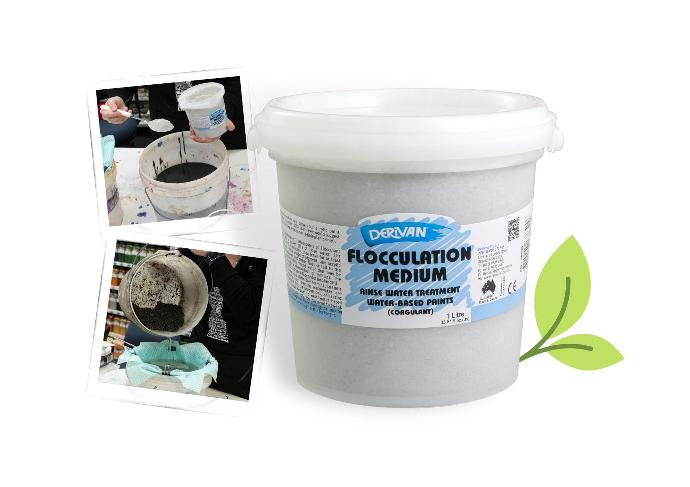Clean Up Acrylic Paint with Flocculation Medium
For Cleaning Wash Up Water From Water-based paint
Derivan brings you a flocculation agent which is the same one that we use to clean our wastewater. This Acrylic Paint Clean up medium comes in 1-litre pails. Perfect for bringing your paint-wash-up water to almost 100% clean. (We suggest only pouring the clean water out into the garden on non-edible plants).
BUY NOW
Pioneering Sustainability in Paint Waste Management
At Derivan, our commitment to sustainability goes beyond just words. Our Flocculation Medium is a testament to our eco-responsible approach to managing paint waste effectively. But that's just a glimpse into our broader sustainability endeavours. We invite you to explore our sustainability page to discover more about how we’re making a difference for our planet while providing you with quality products.
How to Clean up Acryllic Paint using Flocculation Medium
It is used by adding about three tablespoons of Floc agent to a 9-litre bucket of wastewater. This then needs to be stirred thoroughly for 5-10 minutes, then left for at least 3 hours. What should happen is the particles of pigment, acrylic resin etc, will bind together into a thick sludge and will either sink to the bottom or float, leaving almost clear water which can be poured off (through a cheesecloth or other course fabric). The sludge is then left to dry and disposed of into landfill.
Troubleshooting Tips
Each colour is different, and therefore their formulas are different - and therefore, their chemical make-up is different - and their wastewater will be different. So the description and ratios above for Flocculation Medium to wastewater may vary considerably (by multiples). Some fine-tuning will be needed each time - adding more Floc agent, stirring for longer, and leaving to settle for longer are all variables that will change from batch to batch.
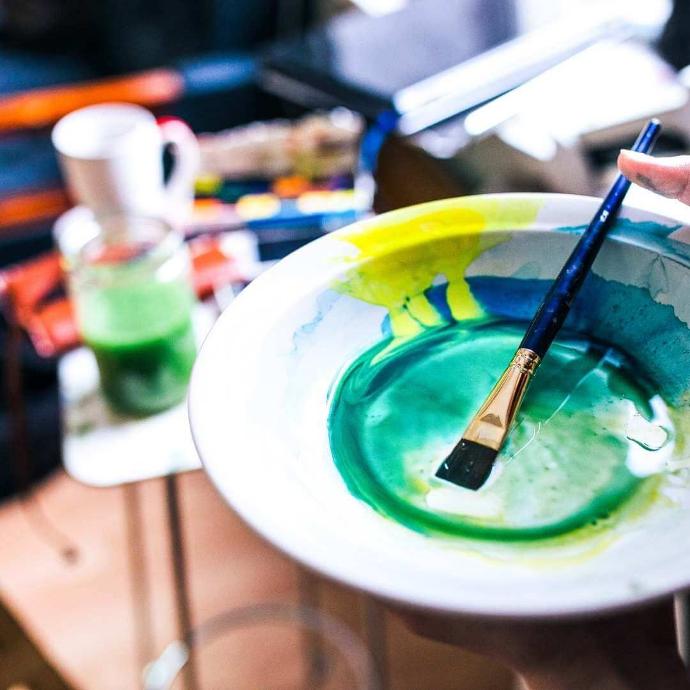
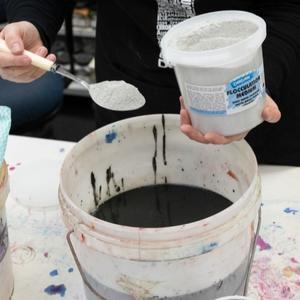
STEP ONE
Flocculant Medium must be mixed with dirty paint water in a ratio of 3 tablespoons fulls to 9 litres of your paint-wash-up water. We have six litres here, so we need two tablespoons. Vigorously stir for 5-10 minutes, then leave for at least three hours (however, this might take a day).
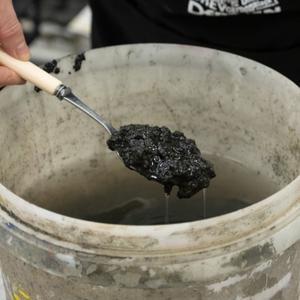
STEP TWO
A thick sludge of pigment and acrylic resin will coagulate and either float or fall to the bottom, leaving lightly tinted water that may be drained off.
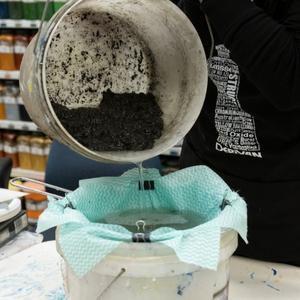
STEP THREE
Separate the sludge from the water by pouring the bucket of treated water through a cheesecloth, chux, or similar material. Leave the sludge to dry in the sun and then discard it into landfill.
THINGS TO CONSIDER BEFORE PAINTING WITH ACRYLICS
Only dispense enough paint/product to be used in the time allotted. This seems like a simple enough idea but is worth mentioning - with a bit of forethought. You can save costs and waste.
Cover and store paints between painting sessions - use air-tight containers with as little "head space" as possible (ie use size-appropriate containers - don't put 20ml into a 250ml container as the air in the container will be enough to dry the paint out!). We have a great range of empty containers for you to use in our Refillable range.
Sealing pallets are available; using stay-wet pallets can prolong the life of the paints. You can store your paint mixes in the refrigerator (not below 4C), which will slow drying time considerably.
You will need to develop and use a method that best suits your practice to prolong the life of the paint you are working with.

CLEANING UP AFTER PAINTING WITH ACRYLIC PAINT
Leave paint on pallets to dry - any excess paint can be left to dry, then once dry, can either be left and more colour mixed over the top or for a clean surface, the paint can be peeled off most surfaces and disposed of into landfill. If this is not practical, use a paper towel to wipe up excess paint and then leave it to dry. You can also use a paper towel to remove leftover paint from brushes and tools.
Once the paint is dry it will not release any of its constituent parts (including heavy metals) into the groundwater in landfill - It is best not to send "wet" paint to the landfill as this may remain wet (if wrapped in plastic for instance) and has a chance of mixing with groundwater.

CLEANING BRUSHES AND TOOLS
Brushes and tools need to be rinsed BEFORE they dry for the most part. The small amount of solids content washed into wastewater is negligible for most artists and can be dealt with efficiently by wastewater plants (of course, local requirements and regulations should be checked and observed),
Hot tip for cleaning up after painting with acrylic paint use Derivans paint brush cleaner and also Derivans Brush Restorer | Brush Cleaner

PAINT WASTEWATER BEST PRACTICE
You may also pour your acrylic paint wastewater onto your plants - the best practice is to only dispose of the water on non-edible plants. If you are a high-volume artist, small co-operatives of artists or a school, the following methods in combination with local requirements and regulations should be followed.
Double trap, using two or more buckets, rinse out your brushes to get the majority of the paint off them in the first bucket, then a final rinse in the second.
Depending on how much waste you have and how often you clean your brushes, you can either leave the water evaporated and peel the residue from the bottom of the buckets and dispose of it in landfill.
If you are every day painter, you may want to use more than two buckets, keep them sealed in a cool place, and leave them for the solids to settle. You can pour the cleaner water from the first bucket into the next one. With the initial bucket becoming more concentrated, you will get to the point where it will become quite thick. As it is pretty concentrated - at this point - leave this with the lid off to dry completely and then dispose of it into landfill. If you find the buckets becoming "smelly" due to bacteria, it is best to leave them to dry out as above. If you find it happens regularly in your climate, it is possible to treat it with a household antiseptic liquid if it only occurs irregularly.

